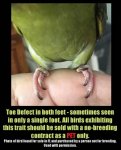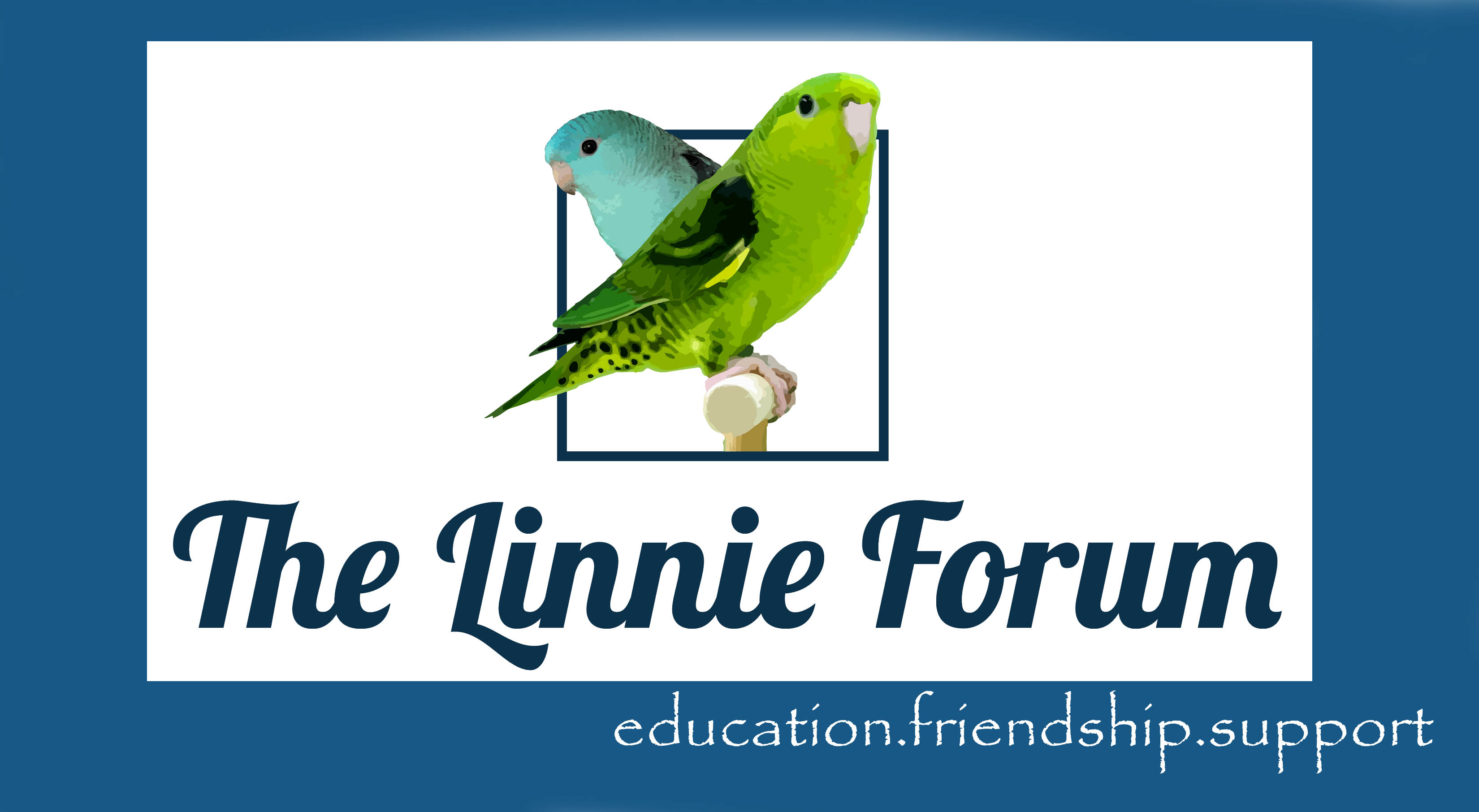Toe Defect Explained
© Eddie’s Aviary - please do not reproduce without permission

The cardinal rule when selecting breeding “stock” is to ensure that they are the finest quality available. Part of that selection process is to ensure that the birds used to pass their genes do not have any hidden or visual congenital defects. The problem sometimes seen in the Lineolated Parakeet with the toes (a rear facing toe facing forward) is one of those congenital problems that must be excluded from the breeding pool. The challenge is that normal toed birds can throw it, so you need to dig deeper to lessen your chances of running across it. Please read below.

Characteristics of the Deformity: See photo above of a double foot affected bird.
What can you do about it? When the toe misplacement is first observed by the breeder, some may try and “correct” the toe placement with tape or a brace. In canaries, there is something called “slipped claw” which some think this defect is. However, that is incorrect. In most cases the bones are fused in the improper place and CANNOT be corrected with splinting. You can tell if the bird has bones in place by gently moving the toe to the proper position. If the bird seems uncomfortable, you will not be able to fix it. This is most often the case.
In cases of severe splay legs, or if the legs are placed straight behind the bird (often caused by a slippery nestbox floor, lack of calcium, genetics, or improper feeding by the parents) the toe displacement may be related to those factors, and not the same trait described here. Those birds may benefit from taping if caught early.
Why did my birds throw a chick like this? In 9/10 examples of this deformity, the birds have come from stock with the greywing mutation in it. Where breeders improperly paired two greywing parents together (or even farther back in the pedigree) it appears the bad toes can pop out in young later, even when neither parent exhibits the malformation.
Can I still offer the bird to a new owner? Yes. It would be unethical to not inform the buyer of the issue as soon as you learn of it. Offer to refund their deposit (or apply to another bird) and discount the total bird sale price is a best practice. Be sure to inform the buyer that the bird CANNOT be used for breeding. Write up a simple contract for the buyer to sign that promises to keep the bird out of the gene pool. This helps to drive home how serious it is.
Show the new owner how to trim the toenail on the affected toe as it won’t wear on the perch and grows faster than the rest. It can snag on toys or cage bars and even grow into the top of the foot if not trimmed often. When holding the bird upside down to trim the nails, gently tap the vent with your finger. This entices most birds to open a clenched foot, making trimming easier (this trick works with nail trimming any Linnie).
Please pet home all normal toed chicks from the same clutch, and it is good measure to make the new owners sign a no breeding contract as well. The species is so hard to come by that most people looking for a pet will not care, and placement is easy.
Final thoughts…. To avoid this genetic issue, please try to pair conservatively (no mutation stacking) and purchase breeding stock that you know doesn’t have a pedigree littered with greywing. If a bird doesn’t have at least known parents (band numbers and mutation) and grandparents, avoid it.
Although it is not 100% known that the gw mutation causes this, it has been seen enough to warrant a strong warning that there is a nexus there (connection).
If you do happen to get a toe defect baby in your offspring, please do not breed those birds again. Do not use even normal toed birds in the clutch for breeding (either for you or sold to someone else). Finding a home for wild breeding birds can be a challenge, so prepare to hold onto them until you find someone looking for an adult same sex buddy for a pet home. They will come up, so be patient, and feel good that you are doing the best for the species as a whole.
If you enjoy this Forum, or the Content found here helpful.... consider buying the author a coffee. Helps with website costs, and keeps motivation levels up for more late night work. Thank you CLICK HERE to Buy Me A Coffee
CLICK HERE to Buy Me A Coffee 
© Eddie’s Aviary - please do not reproduce without permission

The cardinal rule when selecting breeding “stock” is to ensure that they are the finest quality available. Part of that selection process is to ensure that the birds used to pass their genes do not have any hidden or visual congenital defects. The problem sometimes seen in the Lineolated Parakeet with the toes (a rear facing toe facing forward) is one of those congenital problems that must be excluded from the breeding pool. The challenge is that normal toed birds can throw it, so you need to dig deeper to lessen your chances of running across it. Please read below.

Characteristics of the Deformity: See photo above of a double foot affected bird.
What can you do about it? When the toe misplacement is first observed by the breeder, some may try and “correct” the toe placement with tape or a brace. In canaries, there is something called “slipped claw” which some think this defect is. However, that is incorrect. In most cases the bones are fused in the improper place and CANNOT be corrected with splinting. You can tell if the bird has bones in place by gently moving the toe to the proper position. If the bird seems uncomfortable, you will not be able to fix it. This is most often the case.
In cases of severe splay legs, or if the legs are placed straight behind the bird (often caused by a slippery nestbox floor, lack of calcium, genetics, or improper feeding by the parents) the toe displacement may be related to those factors, and not the same trait described here. Those birds may benefit from taping if caught early.
Why did my birds throw a chick like this? In 9/10 examples of this deformity, the birds have come from stock with the greywing mutation in it. Where breeders improperly paired two greywing parents together (or even farther back in the pedigree) it appears the bad toes can pop out in young later, even when neither parent exhibits the malformation.
Can I still offer the bird to a new owner? Yes. It would be unethical to not inform the buyer of the issue as soon as you learn of it. Offer to refund their deposit (or apply to another bird) and discount the total bird sale price is a best practice. Be sure to inform the buyer that the bird CANNOT be used for breeding. Write up a simple contract for the buyer to sign that promises to keep the bird out of the gene pool. This helps to drive home how serious it is.
Show the new owner how to trim the toenail on the affected toe as it won’t wear on the perch and grows faster than the rest. It can snag on toys or cage bars and even grow into the top of the foot if not trimmed often. When holding the bird upside down to trim the nails, gently tap the vent with your finger. This entices most birds to open a clenched foot, making trimming easier (this trick works with nail trimming any Linnie).
Please pet home all normal toed chicks from the same clutch, and it is good measure to make the new owners sign a no breeding contract as well. The species is so hard to come by that most people looking for a pet will not care, and placement is easy.
Final thoughts…. To avoid this genetic issue, please try to pair conservatively (no mutation stacking) and purchase breeding stock that you know doesn’t have a pedigree littered with greywing. If a bird doesn’t have at least known parents (band numbers and mutation) and grandparents, avoid it.
Although it is not 100% known that the gw mutation causes this, it has been seen enough to warrant a strong warning that there is a nexus there (connection).
If you do happen to get a toe defect baby in your offspring, please do not breed those birds again. Do not use even normal toed birds in the clutch for breeding (either for you or sold to someone else). Finding a home for wild breeding birds can be a challenge, so prepare to hold onto them until you find someone looking for an adult same sex buddy for a pet home. They will come up, so be patient, and feel good that you are doing the best for the species as a whole.
If you enjoy this Forum, or the Content found here helpful.... consider buying the author a coffee. Helps with website costs, and keeps motivation levels up for more late night work. Thank you
